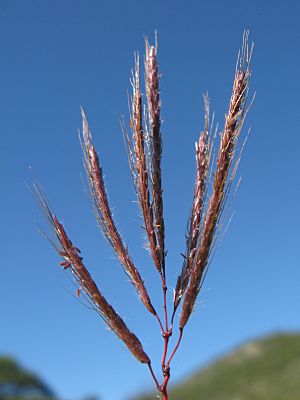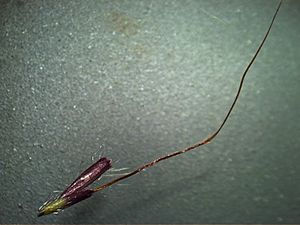Dichanthium annulatum facts for kids
Quick facts for kids Dichanthium annulatum |
|
|---|---|
 |
|
| Scientific classification | |
| Genus: |
Dichanthium
|
| Species: |
annulatum
|
| Synonyms | |
|
Andropogon annulatus |
|
Dichanthium annulatum is a type of grass. It belongs to the Poaceae family, which includes many common grasses. People often call it marvel grass. This plant is very useful because it's a good forage for animals like cows and horses.
Other common names for this grass are Diaz bluestem, Kleberg bluestem, Hindi grass, ringed dichanthium, sheda grass, medio bluestem (for one type), jargu grass, Delhi grass, vuda bluegrass, two-flowered golden-beard, and Santa Barbara grass.
This grass originally comes from tropical Asia, the Middle East, and parts of Africa. It is very important for farming in India. People have taken it to many other parts of the world to grow. In some places, like Australia, it has started growing naturally on its own.
Contents
What Marvel Grass Looks Like
This grass can look a bit different depending on where it grows. Generally, it is a perennial grass. This means it lives for more than two years. It often has stolons, which are stems that spread out along the ground.
The main stems grow outwards first, then stand up tall. A stem can be about a meter long. The upright part can reach about 60 centimeters (about 2 feet) high. Each joint on the stem has a ring of tiny hairs. The leaves can be up to 30 centimeters (about 1 foot) long and feel a bit rough.
The flowers of the grass grow in a group called an inflorescence. This looks like several purplish or green branches. Each branch can be up to 7 centimeters long. Usually, there are 2 to 9 branches, but sometimes there can be up to 15. Each tiny flower part, called a spikelet, can be over 2 centimeters long. This includes its long, twisted awn, which is a bristle-like part. The awn has two bends in it. The roots of this grass usually grow about one meter deep.
How Marvel Grass Reproduces
This grass often makes seeds without needing fertilization. This process is called apomixis. It's like the plant makes copies of itself. However, it can also reproduce sexually sometimes. This means it uses pollen and eggs to create new plants.
Plants of this species can have different numbers of genetic sets. They can be diploid (two sets), tetraploid (four sets), or hexaploid (six sets).
Growing and Using Marvel Grass
Marvel grass is a very popular grass for pasture in many areas. Farmers use it in fields where animals graze. They also cut it to make hay or silage, which are types of stored animal feed.
This grass can grow in many different types of soil. It does well in soils with lots of clay or sand. It can also grow in soils that don't drain well. It even tolerates slightly salty or alkaline soils. When animals graze on it, it forms a strong layer of grass that can handle being walked on.
Marvel grass can recover after fires or dry periods. However, it doesn't like frost or too much shade. It doesn't need a lot of fertilizer to grow well. But, it grows even better if you give it a little bit of nitrogen. Horses and cattle really like to eat this grass.
While this grass can grow very strongly and sometimes take over other plants, it also grows well with certain other plants. These are called companion species. Some good companion grasses include Bothriochloa insculpta, Dichanthium aristatum, and D. caricosum. It also grows well with legumes like Medicago sativa, Stylosanthes hamata, and S. seabrana. Legumes are plants that help put nitrogen into the soil.
This grass can also be used to help bring life back to grasslands that are not doing well. It's very good at holding soil in place, which helps stop erosion. In India, marvel grass is a favorite pasture grass. It is well-known, widely planted, and very successful there. One type of marvel grass grown by farmers is called 'Marvel 8'.
Marvel Grass in Nature
This grass can be a home for many different types of fungus. Most of these fungi do not hurt the grass much. However, it can get a disease called ergot, which is caused by a type of fungus called Claviceps.
It can also be a host for a parasitic plant called Striga lutea. A parasitic plant lives off another plant for its food.
Sometimes, marvel grass can escape from where it was planted and start growing in the wild. It can grow in tough places, like along roadsides. In some areas, it can become a weed. It is considered an invasive species in places like Fiji, Hawaii, and New Caledonia. An invasive species is a plant or animal that spreads quickly and harms the environment. In south Texas, it has taken over large areas and pushed out native grasses. It is even thought to be a reason why a rare plant called the slender rushpea is becoming endangered in the United States.


